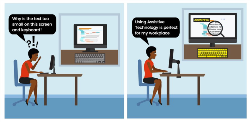All news

Visual Impairment Workplace Risk Assessment
By
Daniel Williams |
December 13, 2018
It isn’t always essential, and you may not necessarily need any adjustments in your place of work.
However, health and safety professionals, risk assessors and employers may be keen to avoid difficulties, ensure that other employees are not also at risk and ensure a working environment with safe working guidelines for all.
Common issues are:
- Dealing with Guide Dogs
- Mobility and travel
- Lighting levels
- Trip hazards
- Working independently
- Evacuation of the building
- Stairway negotiation
- Safe use of computer systems
- Machinery
- Caring for others
How much will I be included in the assessment?
Throughout any risk assessment, it is crucial you feel an informed decision has been made and that you are involved in order that you can work effectively and safely.
More specifically, a risk assessment is not a process designed to exclude you from working in certain environments. There are many examples of blind people working across different sectors, such as senior physiotherapists, sales and marketing managers, politicians, business owners, teachers, administrative assistants.
How can I avoid feeling nervous about an assessment?
The process should not be daunting, stressful or intimidating, nor should you feel assumptions are being made about what you can or cannot do or risks overestimated. It is not acceptable to be told that, ‘you must be risk assessed’ which suggests that you are the issue, rather than certain activities being assessed.
Being blind or visually impaired should not be used as a barrier to achievement or employment because even when risk is highlighted, it should be possible to manage it comfortably.
What can I expect from a Workplace Visual Risk Assessment?
The procedure is a specialist on-site assessment to ascertain areas of improvement in the physical environment in relation to the duties required of an employee.
This may lead to recommendations for assistive technology software, specialist equipment and non-physical disability adjustments.
Your health and wellbeing at work will be taken into consideration as this is essential to ensuring that, as an employee, you can effectively fulfil your role.
What will be assessed?
Your computer software will be examined to see if there are ways of improving accessibility. Recommendations such as using magnification, speech and text-speech software, may be made.
In your working environment, there may be ways to improve employee surroundings which can make the workplace more accessible, and safer to use for everyone.
An assessment may identify areas for training such as staff awareness and the existing level of support provided for you.
An area that is often forgotten is Health & Safety when travelling to and from your place of work. The assessment will therefore look at working hours and if there is any possibility for working at home.
Compliance with the Equality Act 2010 is taken into account in all assessments with the aim of creating a safe and happy working environment with enhanced employee performance, once the recommendations have been implemented.
For more information on our visual workplace assessments visit http://www.visualisetrainingandconsultancy.com/consultancy/










